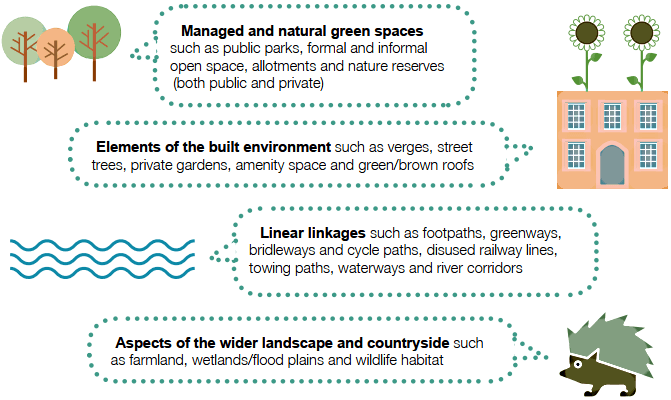Introductory section of Enfield Climate Action Forum's submission to the consultation on Enfield's Blue & Green Strategy
Vision, aims and objectives
The Blue and Green Strategy has real strengths in providing for cycling, water and flood management, climate emergency friendly transport and urban greening. It’s ambitious, with laudable goals and intentions.
Nevertheless, on close reading there are some significant questions regarding specific content, and we feel that some of the benefits anticipated for the strategy are over inflated: the SWOT analysis is rigorous and rings true but the eight strategic programmes, the emerging priorities & areas of change, the individual components of the blue-green infrastructure do not seem to fully address the identified weaknesses and threats, particularly re the impact on health inequalities and carbon emissions.
Neither do they build on acknowledged and important strengths and opportunities such as the use of farmland in the green belt for agriculture, agroforestry and market gardening; providing locally sourced, sustainable supplies of food and timber, supporting the local economy and employment. These latter are overlooked in the strategy which, post Covid 19 particularly, are of vital importance to our young people.
Enfield has a rich farming heritage going back centuries. As acknowledged in the foreword, though not entirely accurately, the blue, green and silver stripes on Enfield‘s official crest actually represent the New River, the Green Belt areas and open spaces in general and have indeed left an indelible mark on the landscape. The upfront ambitions in the foreword describe the corporate desire to remediate degraded environments; increase biodiversity and food production; celebrate our rich landscape heritage and promote green tourism.
In its present form, we feel that the strategy overlooks these ambitions and is more a presentation about parks, open spaces, pathways and (some) waterways than a workable strategy either for the long-term preservation and enhancement of all the borough’s public and private green and blue assets or for making a significant impact on the climate crisis.
The sense of a long-term all-embracing strategy to fulfil the admirable ambitions in the foreword is absent. The single overarching ambition is stated as becoming the greenest borough in London, at the cornerstone of London’s national park. Since Enfield is already, at 900 hectares of parks and open spaces, the second largest expanse in London, this feels like a limiting ambition. Our concern is that all the land in Enfield should be considered part of the strategy and its use be addressed comprehensively and creatively.
We feel that these oversights are largely a result of the failure, at a sufficiently early stage, to consult communities, residents’ associations, environmental groups or even local politicians in scoping the Blue Green Strategy. A huge amount of local knowledge and evidence has been overlooked.
Our priority recommendations
These practical suggestions are necessary priorities to achieve the ambitions in the foreword (as above) and Aims 1 and 2 in “Shared vision and aims”, which are to “Achieve a 25% increase in blue-green infrastructure in Enfield, whilst protecting existing assets” and “Ensure our residents can access blue and green spaces within 15 minutes walking distance of their homes”
- Place Enfield’s farms at the heart of the strategy
- provide local food for local consumption
- boost the local economy and provide skilled jobs
- use the authority of the council as landowner to establish regenerative farming practice to increase carbon take up/ sequestration and other environmental benefits such as for wildlife, flood resilience”
- be a London Market Garden centre of excellence
- promote green tourism
- Create woodlands where they are most needed to address health and social inequalities
- locate them in the east of the borough in the form of “tiny forests” e.g. in existing parks and playing fields (e.g.Durrants, Jubilee, Albany, Bullsmoor Lane, Bellmore playing fields, school playing fields, in the two new parks (Edmonton marshes and Brooks) or as a continuous swathe across Lee Valley to Epping Forest
- use naturally regenerative processes in preference to manual planting to improve resilience and carbon capture
- include policies about existing green spaces
- front and rear gardens to prevent permeable green space and habitat being lost
- management of verges to benefit biodiversity
- school playing fields and other wide open spaces in the east of the borough for “tiny forests”
- commit to register all permissive footpaths in the borough to become rights of way by the 2026 deadline
- create new foot and cycle paths to improve accessibility and ensure that “accessibility” embraces the rights of those with disabilities and are wheelchair and pram friendly.
- Specifically
- New River path from Enfield Town to Waltham Cross
- and, as recommended and scoped by the Enfield Society
- Crews Hill path from the Golf Clubhouse to Cattlegate Farm entrance, parallel to Cattlegate Road, as there is currently no pavement.
- The suggested footbridge across the Lea Valley railway line, at the end of the Boundary Ditch should also cross Meridian Way.
- Green bridge across A10 at Colosseum to access sports village
- Pathways through Rammey Marshes
Links
Enfield Blue & Green Strategy - links to draft and associated documents
Encaf response to Enfield Council's draft Blue & Green Strategy





